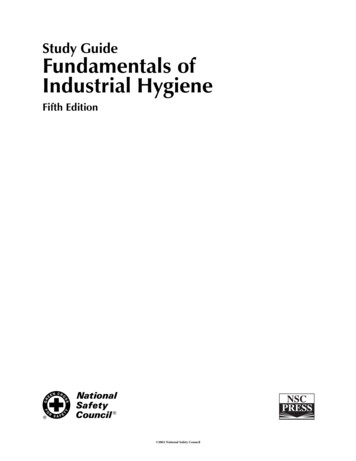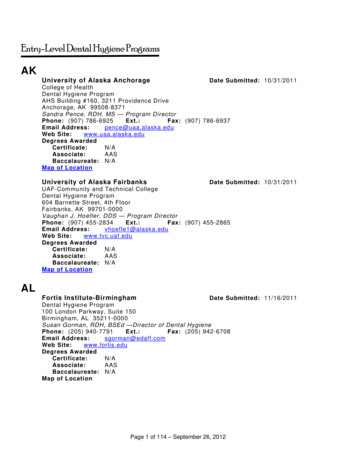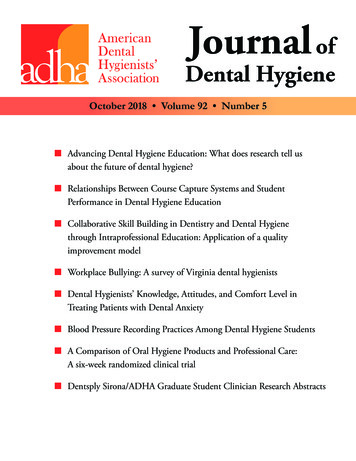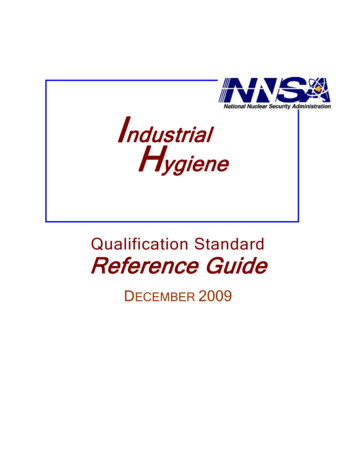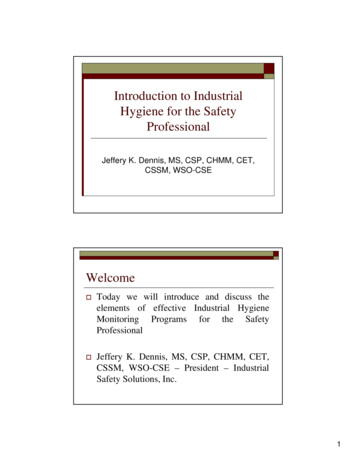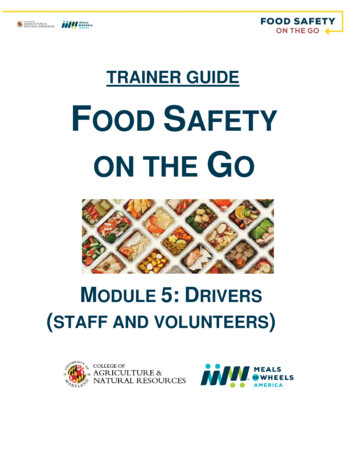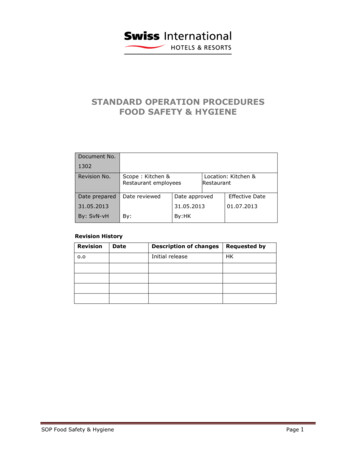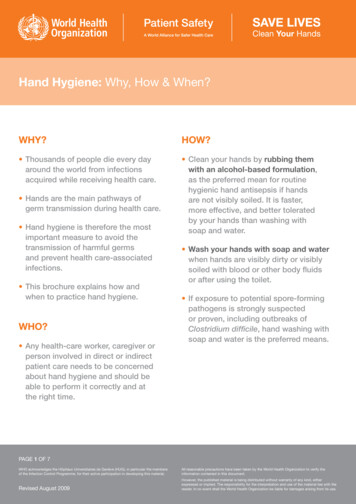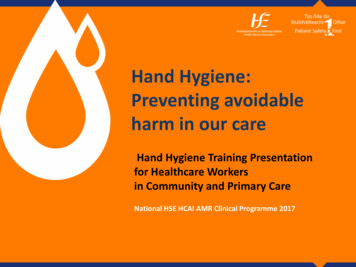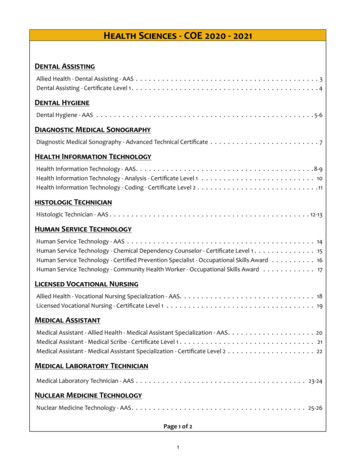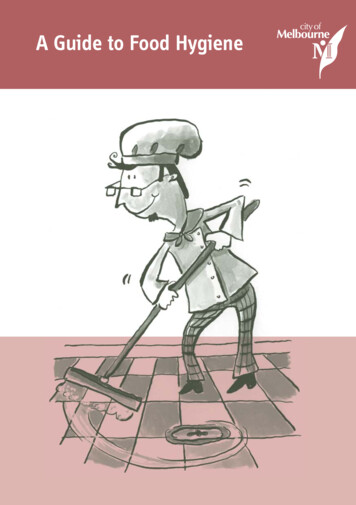
Transcription
A Guide to Food Hygiene
ContentsIntroduction1Topic 1. Food Law and You2What is food safety?Your responsibilities as afood handlerFood poisoning2Topic 2. Food Hygiene– Keeping Food SafeFood safety hazardsFood spoilage and food poisoningHigh risk foodsLow risk foodsThe food poisoning chainWhat to do to prevent itThe right conditions: time,moisture, temperatureTemperature monitoringCross contaminationFood storageThawingCooking, cooling and reheatingBain-maries and pie warmersReady-to-eat foods and ’no touch’techniquesTopic 3. Personal Hygiene15Clothing, nails, hair and jewelleryWash your hands - when, howand what you needWhen you are sickSmokingGloves - How to use and whento change154Topic 4. Cleaning194Clean as you goWhat do I clean with?How do I clean?What is a cleaning schedule?Cleaning SchedulePests - Common pests andwhat they can doGarbageGood house keeping tipsSolutions to 222324 & 25
IntroductionEveryone who handles food in your business needs to know how to handle it safely.Before any person starts work as a food handler, they should have the right skills andknowledge in food safety and food hygiene. It is a legal requirement and part of theFood Safety Program for the business.This guide is designed to give food handlers a basic understanding of why hygiene is soimportant when handling food, how and why food poisoning occurs and what people whowork with food can do to prevent it. The topics cover:1.2.3.4.Food Law and YouFood Hygiene - Keeping Food SafePersonal HygieneCleaningWork through each topic and along the way do the activities to test your knowledge.Solutions can be found at the back of this book.Once you have worked your way through the booklet, pass it on to another staff member orput it somewhere handy. It is a practical reference tool that you can use when doing your job!Throughout this booklet our Food Safety Supervisor championwill provide you with handy tips and important information. Payclose attention to her advice as you work through each topic.1
Topic 1. Food Law and YouWhat is food safety?Food safety is just common sense! It means keeping things clean andserving hot foods hot and cold foods cold.Food safety involves food storage, temperature control, cleaning andsanitising, personal hygiene, and pest control.If you work with food, YOU have an important responsibility to handleit safely.A Food Safety Program is the operating manual for the food businessthat you work in and a requirement under the Food Act 1984. You maybe required to complete records that are part of the Food Safety Program.Your Food Safety Supervisor will be able to show you which records theseare and how to fill them out.ACTIVITY - Food Safety Supervisor says “Have a look at this cartoon. Can you see any food safety problems?There are 20 problems in all to find”.2
Food Safety Supervisor says “As a food handler you have many tasks to do.If you are unsure of how to do them properly justcome and check with me.”Your responsibilities as a food handlerA food handler is anyone in the business who has anything to do with food or a surface thatwill come into contact with food. You could be a food process worker, kitchen hand, a canteenworker, a waiting or serving staff member, a bakery assistant, a sandwich hand, or involved inclearing and cleaning tables.The Food Safety Supervisor in your workplace should be able to help you with anything that youare unsure of.Remember, as a food handler you need to handle and serve food safely. This is one of your keyresponsibilities. You can also be fined under the food law. In Victoria, food handlers mustfollow the Food Act 1984.Food poisoningMost us have experienced food poisoning or knowsomeone who has. While symptoms are similar to manystomach ‘bugs’ – vomiting, diarrhoea, stomach pains,aching joints and generally feeling unwell – some foodpoisonings can cause death, especially in children, theelderly and the very ill.Food poisoning is serious and also costly due to thefollowing possibilities: Customers getting sickDeath in severe casesClosure of the food premisesLoss of jobsBad publicity/loss of reputation by media/word ofmouth Legal action taken by affected customers3
Topic 2. Food Hygiene – Keeping Food SafeFood hygiene is not only about cleanliness. It is also about taking the correct steps to makesure that the food that you handle and serve is safe.Good food hygiene practices means that you will have satisfied customers, a safe and cleanworkplace, and meet your legal requirements.Bad food hygiene practices can lead to food contamination and outbreaks of food poisoning.Food safety hazardsA food safety hazard is something found in food that shouldn’t be there. Hazards can beharmful once in the food. This is called contamination.There are three types of hazards that can contaminate food:Microbiological hazards - include bacteria, fungi, yeasts and moulds.Chemical hazards - food contaminated by cleaning chemicals or pesticides.Physical hazards - things found in food that are not meant to be there.Imagine finding some of these things in your food: Hair, fingernails or band aidsBolts, wire, nails or screws from machineryGlass, wood chips or razor bladesMaggots, moths or fliesFood Safety Supervisor says “As a food handler you are responsible for serving safe food.Be aware of these food safety hazards!”Food spoilage and food poisoningFood spoilage is when food goes ‘off’. Some examples include sour milk, mouldy bread, andvegetables that have gone green and slimy. The smell, taste and look of the food make it unfit toeat and should be thrown away, however this is not food poisoning.Food poisoning is different to food spoilage becauseyou can’t see or smell any difference in the food.The food looks, smells and tastes normal even thoughthere are many food poisoning bacteria on the food.4
High risk foodsBacteria need food to survive and there are certain types of food that food poisoning bacteriagrow well in. These are grouped together and called high risk foods.These high risk foods are also called potentially hazardous foods. They are high in protein andwater content (they are often moist) and include: Eggs and egg products (such as cooked eggs in salad) Rice (cooked or partially cooked) and pasta (cooked or fresh) Beans (cooked or partially cooked) such as kidney,lima or borlotti beans Raw and cooked meats Fish and poultry Stuffing for meat and poultry Stews, soups and stocks Pizza, sandwiches and filled cakes Milk and dairy products such as cream, cheese and custards Sauces and gravies Processed and canned meats (after opening) Shellfish (especially oysters)Low risk foodsBacteria don’t grow well in these foods:Dry - Packaged foods such as flour, tea, coffee, dry pasta, sugar and dried fruits are safefoods. These foods don’t need refrigeration and have a long shelf life. However many driedfoods become high risk foods once water is added - for instance cooked rice or pasta.Frozen - No bacterial growth occurs in frozen foods as water is in solid form. Bacteria will growonce the food is defrosted.High in acid - pickles, chutneys, tomatoesHigh in salt and sugar - salty and sweet foods5
The food poisoning chainA chain of events take place before food poisoning occurs:Source of food poisoningTransfer of bacteriaGrowth of bacteria (in the right conditions)Food is eatenFOOD POISONING There must be food poisoning bacteria on the food The bacteria must have the right conditions to multiply The food must be eaten for food poisoning to occurWhat to do to prevent itThere are three steps that can betaken to prevent food poisoning:Step 1 - protecting food frombacterial contamination with correcthandling and storage.Step 2 - preventing the growth ofbacteria in food through time andtemperature monitoring.Step 3 - destroying or reducingbacteria present in food by cookingfood thoroughly - this can bechecked using a thermometer.6
The right conditions: time, moisture, temperatureTimeUnder the right conditions, bacteria can multiply every20 minutes. This means that in 3.5 hours, one bacteriumcan become one million bacteria.MoistureBacteria need moisture to grow. If there is no moisture,the growth may slow down or stop. This is why dryingfood is a safe way to preserve it.Temperature100Bacteria grow in temperatures between 5 C and 60 C.This temperature range is called the Danger Zone.90At 5 C bacteria start growing. They grow faster as thetemperature rises up to approximately 45 C when theirgrowth slows.8070Bacteria stop growing at around 60 C. Food must be cookedto reach a core temperature above 75 C to kill bacteria.60Food in the freezer - Bacteria are not active when food is frozensolid (-18 C and below).50Food in the refrigerator - Temperatures (0-4 C) prevent mostfood poisoning bacteria from growing.4030DangerZoneFood at room temperature – Food is in the Danger Zone(5-60 C) which are ideal conditions for bacteria growth andreproduction.20100TAKE CARE: Foods are not to be in the danger zone(between 5 C and 60 C) longer than necessary.7
Temperature monitoringThe temperature of food is taken using a probe thermometer. To take the temperature of foodsyou should:1. Wash the probe. Rinse the probe under hot running water before each use.2. Sanitise. Wash in sanitising solution or use sanitising wipes before each use.3. Insert. Put the probe into food.4. Read and record. Write down the temperature on the Food Safety Program record form.WashSanitiseInsertRead/recordIf you don’t think that the reading sounds right or the food is between 5 C and 60 C,check with your Food Safety Supervisor.Food Safety Supervisor says “Remember always: Take the core (internal) temperature by putting the probeinto the thickest part of the food Stir liquids (such as soups and sauces) before taking temperature Wash and sanitise the probe between every reading”8
Cross contaminationFood poisoning bacteria are all around us everyday. They can be found in the soil,on animals, on our skin and our things. In fact, everything that we touch and use!Cross contamination is when bacteria contaminates food or a food contact surface.Food is usually cross contaminated by food handlers incorrectly handling food.Here are some dos and don’ts for when handling food: Do Keep raw meat and vegetables awayfrom cooked food Keep cooked meat above raw meatin the refrigerator Keep food covered to protect from dust,flies and dirt Thoroughly rinse/wash all fruit andvegetables in clean water to remove soil,insects and chemicals Clean and sanitise all equipment andbenches Keep food stored in food-gradecontainers Wear clean protective clothing Wash hands before handling food Don’t Chop raw and cooked meat on the same chopping boardHandle raw food then cooked foodwithout washing your handsUse food handling gloves for handlingmoneyStore food uncovered in the fridgeor cool room Remember, make hand washing and good personal and foodhygiene habits a way of life.Food Safety Supervisor says Did you know that it is really easy to cross contaminate food through: Food handlers’ poor hygiene habits Your suppliers Storing foods incorrectly9
ACTIVITY - Food Safety Supervisor says “Read Joe’s diary carefully and determine which tasks wereperformed correctly”. (Insert or )Right Wrong Sliced vegetables with a clean and sanitised knifeUsed the same knife to slice the cooked hamWashed tomatoes in the hand-wash basinPut sliced ham in a covered container and placed it on thetop shelf of the refrigeratorPlaced the hot soup by the open window to cool quicklyWent outside for a cigarette and washed his hands whenre-entering the kitchenUsed the same chopping board to cut up raw meat andcooked meatFood storageStoring food correctly is important in any kitchen. There are three main food storage areas:1. The dry store for the storage of dry ingredients2. The refrigerator or cool room for the storage of fresh perishable food3. The freezer for the storage of frozen foods1. Dry food storage in the dry store (pantry/larder)Dry foods like flour, tea, coffee, dried pasta, sugar, breadcrumbs, herbs and spices can be keptin the dry store or pantry. These foods have a long shelf life because they are dry. They can bekept at room temperature.Always Store dry foods such as flour, herbs and spices and dried pasta, oil in cartons, tins orcontainers with tight fitting lids. Check for signs of dampness, the use-by date, dented or rusty cans, and holes inpackaging. Store food on shelves off the floor and store chemicals in a separate area. Rotate stock – first in, first out rule.10
2. Cold food storage in the refrigeratorHigh risk foods must be kept in the refrigerator at 5 C or cooler. Do Store cooked food above raw food. Keep opening and closing of the doorto a minimum. Defrost regularly and make sure that therefrigerator is in good repair and keptclean. Cover, label and date foods. Rotate stock – first in, first out rule. Don’t Over stack the refrigerator or the cold air can’t circulate.Put hot food straight into the fridge.Store cans in the fridge once they havebeen opened.Food Safety Supervisor says “Remember keep food covered, labelled and dated!!!!”3. Frozen food storage in the freezerFrozen food should be kept in a freezer that is cold enough to keep the food rock solid frozen(-18 C and below).Remember Frozen foods can still contain bacteria, and once thawed, the bacteria will again start togrow. Keep freezers at -18 to -20 C and in good working order. Frozen food must be rock solid frozen. When receiving food from suppliers check that it isfrozen solid. Don’t overload freezers. Cover, label and date foods. Rotate stock – first in, first out rule.11
ThawingIt is important that food is completely thawed before cooking. If the food is still partly frozen itmay not reach the right temperature on the inside to kill food poisoning bacteria.Always Thaw food in a refrigerator or microwave (defrost).Allow plenty of time to thaw thoroughly.Cook food within 24 hours of thawing.Check the temperature of the food with a probe thermometer.Cover, label and date foods.Remember:Don’t re-freeze food once it has thawed.ACTIVITY - Food Safety Supervisor says “Don’t forget to thaw food completely before cooking, or the insideof the food may still be frozen and not get hot enough to kill foodpoisoning bacteria”.“Food must be stored correctly in the fridge.Put a letter in each box to show where you should store each food”.A. Prepared saladsB. Cooked hamC. Raw chickenD. Sponge cake with cream12
Cooking, cooling and reheatingCooking food thoroughly is an important aspect of food hygiene and a way to prevent foodpoisoning. Make sure that all foods, especially high risk food, is cooked to an internal coretemperature of 75 C or higher. This will kill most bacteria.Cooking Cook food to 75 C or higher. Stir liquids to heat evenly. Re-cook meat that is cut from gyros on a hotplate.CoolingSometimes you may want to cook food and then cool it and re-heat it for service the next day.Special rules apply when doing this: Cool food quickly.Decant food into shallow containers.Portion food into small amounts to cool faster.Put foods into the cool room or fridge - don’t leave it on the bench or stove to cool.TAKE CARE: Foods are not to be in the danger zone(between 5 C and 60 C) longer than necessary.Reheating Re-heat food by the quickest method, making sure the core temperature reaches 75 C. Food should only be reheated once and then thrown out if not eaten or sold. If heating food in the microwave, make sure that it is re-heated all the way through.Remember Food Safety Supervisor says.“Work quickly with high risk foods in the danger zone.Cook and re-heat foods by the quickest method and cool foodsquickly by breaking them down to smaller quantities”.13
Bain-maries and pie warmersBain-maries and pie warmers should only be used for keeping HOT food HOT for a short timeduring meal service. They are NOT to be used to cook or reheat food. Do Ensure temperature of bain-marie Don’t Mix fresh with those already onis greater than 60 C prior to loading. Take the temperature of hot food. Clean regularly. Replace trays.display. Overload with food. Use to heat or cook food.Food Safety Supervisor says “Remember to heat food in the oven before putting into abain-marie or pie warmer and use separate tongs, spoons andserving utensils for each tray in the bain-marie”.Ready-to-eat foods and ‘no touch’ techniquesReady-to-eat foods can be eaten or served straight away without any further food preparationsuch as cooking or heating which would normally kill bacteria.Some ready-to-eat foods include: Hot meat pies, pasties, sausage rolls and cooked pizza Prepared sandwiches and filled rolls Cakes, pastries, custards, yoghurt and cheese Cut fruit, salads, dips, sushi and ice cream Cooked rice, pasta and noodle dishesFood Safety Supervisor says “Take care when handling ready-to-eat foods so that they won’t becontaminated. Use ‘No Touch’ techniques. These techniques put abarrier between the food and your hands to protect the food”.Always use a ‘no touch’ technique Use tongs and serving spoons to handle food. Grab or hold food using a piece of food grade grease proof paper or paper serviette. Use clean food handling gloves to handle food.14
Topic 3. Personal HygieneEveryone has bacteria on and inside their bodies. You havebacteria on your, skin, hands, underneath fingernails, in yourhair, ears, nose and throat and other body areas.About 64 per cent of the population carry food poisoning bacteria(Staphylococcus aureus) in their ears, nose, and throat and on their hands.As a food handler you must be careful not to contaminate food withthese bacteria. This topic details personal hygiene ‘dos’ and ‘don’ts’.Personal hygiene is making sure that the food handler is cleanand knows what to do to keep food clean and safe.Clothing, nails, hair and jewelleryClothingThe uniform that you wear in the food industry is designed to protectfood from your body and will depend on the kind of food that you handle.Your clothing should not contaminate food or a food contact surface.Protective clothing includes: overalls; aprons; uniforms; protective coats;hair nets/hats; beard snoods and disposable food handling gloves. Do Store personal belongings and clothingin a locker or changing room Wear a clean, well-fitted uniform andshoes to protect the food Take off your apron when you go to thetoilet or outside the food preparation area Don’t Store personal belongings and clothing in food preparation or food storage areas.Change in the toilet.Wear unsuitable clothes for food handlingsuch as shorts and thongs.Nails, hair, and jewelleryNails, hair, and jewellery harbour bacteria and can also fall into food.Nails Do Keep them short and clean. Don’t Wear artificial nails as they can falloff and into food. Wear nail polish as it can chip off intofood. You also won’t be able to see ifyour nails are clean underneath.15
Hair Do Keep hair clean and tied back whenhandling food. Don’t Touch or comb your hair when preparingfood.Jewellery Don’t Wear watches and rings as bacteria live on watchstraps and jewellery. Wear rings or body piercings with stones as they can fall into food. Touch your face and body piercings.Remember that jewellery can: Be an occupational health and safety hazard. It can heat up near cooking appliances andburn your skin. It can also get caught in machinery Stop you from washing your hands thoroughly.Wash your hands - when, how and what you needWhen to wash your handsYour hands come into contact with food all the time. Wash your hands thoroughly before andduring work to keep the number of bacteria down.Always wash your hands after: Handling rubbish, washing out rubbish bins and cleaningGoing to the toilet and starting work or coming back from a breakBlowing your nose, coughing or sneezingSmokingEating or drinkingHandling moneyTouching any part of your body like scratching, touchingearrings or your hair or wiping sweat from your forehead After handling raw food and before handling ready-to-eat food16
How to wash your handsStep 1:Apply soap and wet hands with warm waterStep 2:Wash. Use soap and warm water to thoroughly wash your hands right up to theforearm and between your fingers for at least 60 seconds.Step 3:Rinse hands under warm, running water.Step 4: Dry hands using an air dryer or paper towel.Apply soapWashRinseDryWhat – you need to wash your hands1. Soap, (liquid antibacterial soap is best for hand washing as it kills bacteria and is nonperfumed)2. Warm running water3. Disposable paper towels or an air dryer4. Rubbish bin to throw the used paper towels intoTalk to your Food Safety Supervisor if your hand wash area hasrun out of supplies of soap or paper towels.Food Safety Supervisor says “Don’t use the food preparation sink for hand washing.Never use the hand wash basin for food preparation”.17
When you are sickAs a food handler you have a responsibility to tell your Food Safety Supervisor when you aresick in order to avoid contaminating the food.Remember: Never cough or sneeze near food or a food contact surface.Food Safety Supervisor says “If you are sick it is best to go to your doctor, get a medical certificateand take your doctor’s advice about when you can return to work.I must record your illness in the Food Safety Program”.SmokingSmoking is not allowed in any area where food is received, stored,prepared, transported or served.Ash, cigarette butts and smoke can all contaminate food.Smoking can also cause coughing which can contaminate food.When smoking, harmful bacteria are passed from your mouth, toyour hands and onto the food. Make hand washing a habit!Gloves - How to use and when to changeFood-handling glovesDisposable food-handling gloves are a great tool to help you handle food safely.Dirty food- handling gloves can be worse than dirty hands and can contaminate food. Do change your gloves frequently(such as every half hour) and: After handling garbage After every break Between handling raw and cooked foods Don’t use food-handling gloves for: Anything other than handling food For handling money For cleaning, handling packaging orpicking things up off the floor When moving from one task to the nextCuts and woundsCover with a blue food handler’s band-aid and disposable glove.18
Topic 4. CleaningClean as you goIn any business, surfaces and equipment become unclean because of food scraps, grease orother mess. This can be hazardous!Cleaning is the process of removing dust, grease, odours, dirt and stains from all surfaces,fixtures (such as lights, cupboards and shelving), utensils and equipment – not only inside abuilding, but also outside, in the backyard and in rubbish areas.There are many reasons why cleaning is important in food handling areas: Customer satisfactionPrevents food poisoningPrevents disease spreadingCreates safe working conditionsHelps keep equipment well maintainedManual cleaningThis involves cleaning dirt, grease and food scraps off surfaces using cleaning equipment suchas brooms, mops and scrubbing machines and/or hot soapy water.Microscopic cleaningThis involves killing bacteria on the surface being cleaned by using either very hot water or asanitiser.Food Safety Supervisor says “Cleaning should always be seen as a preventative measure,not as an afterthought so you should ‘clean as you go’.If left until the end of the day, the cleaning tasks are biggerand you may be too tired to start on a big cleaning job.”What do I clean with?Cleaning equipmentIt is important to have good cleaning equipment such as mops, brushes,protective clothing, gloves and chemicals.All cleaning equipment should be kept in a good and clean condition toavoid spreading bacteria.Remember to always store cleaning equipment away from food areas.19
DetergentsDetergents are used to remove grease, dirt and grime from surfaces.Detergent is like soap – it only removes surface bacteria – it doesnot kill bacteria.Food grade sanitisersA sanitiser is used after the detergent and kills bacteria. Sanitisers can be chemicals or veryhot water (80 C to 85 C). Methylated spirits and water (75/25 per cent ratio), chlorine bleach,or a commercial chemical sanitiser can be used.It is not an option to use either a detergent or a sanitiser – both MUST be used.DisinfectantsDisinfectants are chemicals which often have a strong smell. They are used in toilet anddressing room areas and should never be used in the place of sanitisers.How do I clean?There are four steps that need to be taken to clean and sanitise effectively.The steps apply to all food businesses and to all equipment, surfaces, floors and walls.Step 1: ScrapingLoosen and remove food scraps,dirt and grease by soaking,scraping and rinsing.Step 2: Main cleaningRemove surface dirt, grime, fooddebris or grease by washing andscrubbing using a detergent.Step 3: SanitisingStep 1: ScrapingStep 2: Main cleaningStep 3: SanitisingStep 4: Air dryingUse a chemical sanitiser orvery hot water.Step 4: Air dryingAllow cleaned items to air drynaturally on a clean, sanitisedsurface. Air drying is an importantstep in the cleaning process.Tea towels should be avoided asthey are excellent breeding placesfor food poisoning bacteria.20
Food Safety Supervisor says “Remember to air dry plates. Don’t be temped to pickup a damp tea towel and wipe them as you won’t be dryingthem but contaminating them instead!”What is a cleaning schedule?Your Food Safety Supervisor will use a ‘cleaning schedule’ to keep track of vital cleaning tasks.Food preparation areas and equipment should be cleaned: Before use each day During the day At the end of the dayAs a food handler you are responsible for certain cleaning tasks, and to sign the cleaningschedule. Your Food Safety Supervisor will check the cleaned item and the schedule to seethat it is filled in daily.The schedule should be put on a wall or noticeboard where everyone can see it.The schedule includes details about: Who is to cleanWhat is to be cleanedHow it should be cleanedWhen it should be cleanedWhat chemicals, materials and equipment are requiredCleaning ScheduleEXAMPLE OF A CLEANING SCHEDULEITEMWHOWHENHOWWHAT WITH1. Kitchen FloorsPeter Evans1. After Spillages1. Sweep entire area, especially where thefloors meet the walls and coving2. Mop with hot water and detergent3. Mop with sanitiser4. Allow to air dryBroom, Dustpan,Vacuum, Mop,Wringer Bucket,Detergent Sanitiser2. PreparationbenchesPeter Evans1. Start of day2. After spillages3. End of day1. Remove loose debris with clean cloth2. Wash in hot water and detergent3. Apply sanitiser4. Allow to air dryHand ScraperClean ClothDetergentDouble Sided Bucket21
Pests - Common pests and what they can doPests spread disease through bacteria and droppings. They can cause foodpoisoning and damage equipment and premises. It is vital that pests are keptout of food preparation and handling areas.The most common pests that cause a threat to food areas are flies,cockroaches, ants, rats, mice and weevils.Food Safety Supervisor says “Let me know if you see any evidence of pests”.GarbageHandling and disposing of garbage correctly is vital in any food premises to minimise the risk ofcross contamination, odour and pests. Like most cleaning tasks, managing the rubbish is justcommon sense.Bins in food preparation/service areas Empty bins regularly – after each meal service or when full Wash out the bin with hot soapy water and line with plastic bin linersCouncil garbage bins Hose down the area where bins are storedClose the bin lid and make sure that it is not too fullDo not compress garbageWash out the bin with hot, soapy waterTell your Food Safety Supervisor if there are not enough bins(or when they are overflowing).Food Safety Supervisor says “Don’t forget to separate recyclables like glass, paper,cardboard, aluminium cans, plastic and put them intoa separate bin for collection”.22
To download the City of Melbourne’s Waste Wise Guide, got towww.melbourne.vic.gov.au/wastewise.Good house keeping tipsGood housekeeping is everyone’s responsibility in the food industry.Food Safety Supervisor says “Clean up after yourself and put things away after you havefinished with them. Pick things up off the floor and put things back into storageareas where they should be. Wipe up spills on the floor before someone falls over. Make sure that food ingredients are stored correctly. Check to see that chemicals are labelled properly. Empty bins when they are full. Replace hand washing supplies like paper towels if you seethe dispenser is empty. Ask what else you can do to help and report any mishaps to me. Remember to ’clean as you go’.”23
Solutions to ActivitiesDirty KitchenDid you find (from page 3)Cleaning and sanitising- dirty tea towel- cold water used for washing dishes in sinkGarbage and pests- Lid partly off garbage bin- Open window and no fly screens- Plate of food left to cool by the open windowCleaning and storage- Cracked plates that cannot be cleaned and sanitised- Open tins and packets- Chemicals incorrectly stored with foodTemperature control and food storage-Fridge door openLeg of meat left out of the fridgeRaw steak placed above cooked lambBlood and juices dripping onto cooked meatPest control- Mouse hole in skirting board and trail of mouse droppings on floorPersonal hygiene-Smoking in a food preparation areaHair is uncoveredBandage on finger uncoveredDirty clothingNo protective uniformCross Contamination- Cutting up chicken and meat on the one work surface- Blood from steak contaminating work bench24
Joe’s diary (from page 10)Right Wrong Washed tomatoes in the hand-wash basin Put sliced ham in a covered container and placed it on thetop shelf of the refrigerator Placed the h
Food safety involves food storage, temperature control, cleaning and sanitising, personal hygiene, and pest control. If you work with food, YOU have an important responsibility to handle it safely. A Food Safety Program is the operating manual for the food business that you work in and a requirement under the Food Act 1984. You may
